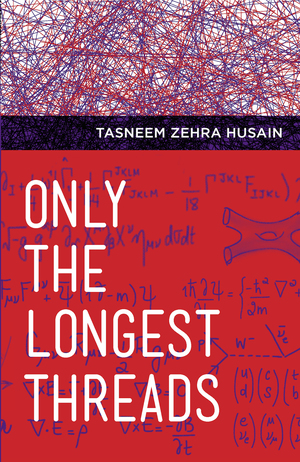Advertisement
Pakistan's First Female String Theorist Publishes Novel On Scientific Discovery
Resume
Tasneem Zehra Husain is a theoretical physicist who has a love affair with science. She asks, "What happens when our understanding of the universe is challenged? In those grand and terrifying moments, what do scientists think, and how do they feel?"
Husain has written a novel that takes you back in time to explore some of the most important scientific discoveries and theories that have shaped our understanding of the world and universe, from quantum mechanics to string theory.
Her fictional characters are science enthusiasts, who witness and illuminate these new theories: a young English boy who's enthralled by Newton's work. An American school teacher who's inspired by Einstein and who waits at Battery Park to welcome him to New York.
It's not science fiction, but science in fiction, and it's called "Only the Longest Threads."
Guest
Tasneem Zehra Husain, theoretical physicist and Pakistan's first female string theorist. She tweets @tasneemzhusain.
Highlights
On her "love affair" with physics:
Tasneem Zehra Husain: “It’s something that’s intensely emotional, and I think that’s true for all professional physicists. We all love what we do...that doesn’t always make it across to the public. So, I don’t know why it is, but over the years, for a combination of reasons, science is always portrayed as something that is very objective. It’s harsh, it’s done, it’s decided, it’s written in stone. And that’s so not true. And what I wanted to do was to write something that reflected the facts but also the feelings of science...It was a labor of love.”
On writing “science in fiction” instead of “science fiction”:
TZH: “When I would talk about [the book] to people...the first reaction would always be, ‘Oh, it’s science fiction.’ And I had to sort of clarify that for myself because it’s almost like you’re inventing a genre...I was kind of scared about how that would work out, how people would perceive it and how I would do it because it’s not something that I’ve seen done before. So, I was a little terrified, but I knew that I wanted the emotions to come through and I felt like you just can’t do that in non-fiction...When I was writing about the different theories, I wanted to represent the vast cast of characters that partake in science...It’s this very big human drama, and the scope of it is much richer than we normally hear about...we hear about the Nobel laureates and the very famous scientists, but we don’t always hear about all these people who love these things very passionately, who love these ideas, but are just everyday people. And those make up the vast number of people who do science.”
On researching scientific theories for the book:
TZH: "I’m a research geek. I love research. I did a lot more than I think was strictly needed. But what was very important for me was to capture the essence of the time when these discoveries were happening."
On making scientific discoveries “come alive”:
TZH: “Each of us relives the history of thought in our own minds. Just because someone discovered something a hundred years ago, it’s still new for me when I see it. But if it’s presented to me as something that’s already old, I become blase about it without really considering the options. And I wanted all of these characters to talk about things that were happening that were new at the time, and for them to convey that excitement...That’s what my hope is. That those ideas will come alive again and people will really feel them for what they are.”
On the title of the book:
TZH: “It’s a quote by Richard Feynman who was a Nobel laureate and was also mentioned in the book. He was one of the people who was responsible for coming up with quantum electrodynamics and he was also an amazing teacher...He said, ‘Nature uses only the longest threads to weave her tapestry.’ So the point was the design is sort of repeated. Whatever piece of nature you look at, they’re such long threads that are weaving through that design that even if you look at a little piece, you get an idea of what’s going on in the whole tapestry...There’s a continuity and there are these repeated motifs. And whatever you pick up when you look at it is connected to everything else...We portray science as being sort of clinical and cleaned up. We show people the result when it’s all done. And if they don’t know the process and they don’t know how much people suffered while creating this really beautiful construct, I think that’s also very alienating. Because it seems like, you know, there’s this perfect thing out there and there are these big geniuses. They understood everything and it must have been so simple for them, and if it’s not immediately obvious to me, I must be too dumb to understand it...I think, if you realize it, everyone struggles with these ideas...If you’re struggling and you realize that all the geniuses throughout time struggled — it somehow makes that okay.”
On working with string theory and writing "Only the Longest Thread":
TZH: "We’re trying to understand the fundamental building blocks of the universe. What practical application will that ever lead to? I don’t know yet. So it’s a very abstract thing, and that’s why I wanted to write this book, to show why we deal with abstract ideas. There’s no immediate practical application that I know of. I’m happy to spend my life doing this. Why? There has to be some kind of emotional trade-off for me, and I wanted to explain what that is.”
This article was originally published on December 03, 2014.
This segment aired on December 3, 2014.